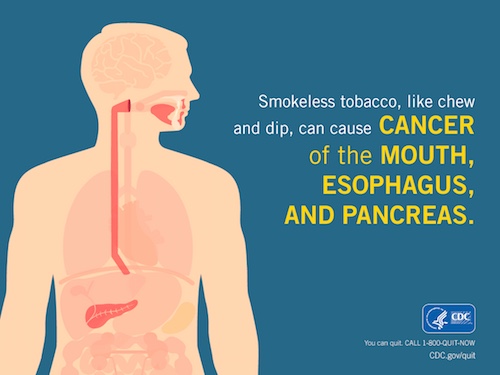Smokeless Tobacco: Health Effects
On This Page
- Addiction to Smokeless Tobacco
- Smokeless Tobacco and Cancer
- Smokeless Tobacco and Oral Disease
- Reproductive and Developmental Risks
- Other Risks
- References
Smokeless tobacco is associated with many health problems. Using smokeless tobacco:
- Can lead to nicotine addiction1,2
- Causes cancer of the mouth, esophagus (the passage that connects the throat to the stomach), and pancreas (a gland that helps with digestion and maintaining proper blood sugar levels)1,2
- Is associated with diseases of the mouth1,3
- Can increase risks for early delivery and stillbirth when used during pregnancy2
- Can cause nicotine poisoning in children4
- May increase the risk for death from heart disease and stroke1,3
Using smokeless products can cause serious health problems.
Protect your health; don’t start. If you do use them, quit.
Addiction to Smokeless Tobacco
- Smokeless tobacco contains nicotine, which is highly addictive.1,2
- Because young people who use smokeless tobacco can become addicted to nicotine, they may be more likely to also become cigarette smokers.5
Smokeless Tobacco and Cancer
- Many smokeless tobacco products contain cancer-causing chemicals.1,6
- The most harmful chemicals are tobacco-specific nitrosamines, which form during the growing, curing, fermenting, and aging of tobacco. The amount of these chemicals varies by product.1
- The higher the levels of these chemicals, the greater the risk for cancer.2
- Other chemicals found in tobacco can also cause cancer. These include:6
- A radioactive element (polonium-210) found in tobacco fertilizer
- Chemicals formed when tobacco is cured with heat (polynuclear aromatic hydrocarbons—also known as polycyclic aromatic hydrocarbons)
- Harmful metals (arsenic, beryllium, cadmium, chromium, cobalt, lead, nickel, mercury)
- Smokeless tobacco causes cancer of the mouth, esophagus, and pancreas.1
Smokeless Tobacco and Oral Disease
- Smokeless tobacco can cause white or gray patches inside the mouth (leukoplakia) that can lead to cancer.1
- Smokeless tobacco can cause gum disease, tooth decay, and tooth loss.1,3
Reproductive and Developmental Risks
- Using smokeless tobacco during pregnancy can increase the risk for early delivery and stillbirth.2
- Nicotine in smokeless tobacco products that are used during pregnancy can affect how a baby’s brain develops before birth.2,7
Other Risks
- Using smokeless tobacco increases the risk for death from heart disease and stroke.1,3
- Smokeless tobacco can cause nicotine poisoning in children.4
- Additional research is needed to examine long-term effects of newer smokeless tobacco products, such as dissolvables and U.S. snus.
Other facts about Smoking
- Smoking leads to disease and disability and harms nearly every organ of the body.
- Cigarette smoking remains the leading cause of preventable disease, disability, and death in the United States.
- The tobacco industry spends billions of dollars each year on marketing cigarettes.
- Smoking costs the United States hundreds of billions of dollars each year.
- States do not spend much of the money they get from tobacco taxes and lawsuits to prevent smoking and help smokers quit. CDC recommends that states spend 12% of those funds on tobacco control.
- In 2020, 12.5% of U.S. adults (an estimated 30.8 million people) currently smoked cigarettes: 14.1% of men, 11% of women.
- Each day, about 1,600 youth try their first cigarette.
- Many adult cigarette smokers want to quit smoking.

